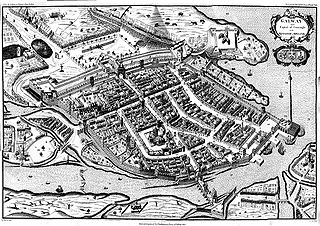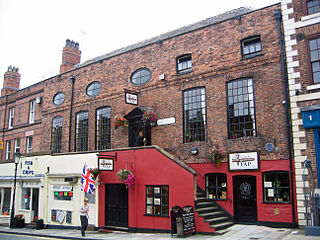Related Research Articles

Galway is a city in the West of Ireland, in the province of Connacht. It is the county town of County Galway, which is named after it. It lies on the River Corrib between Lough Corrib and Galway Bay, and is the sixth most populous city on the island of Ireland and the fourth most populous in the Republic of Ireland, with a population at the 2016 Census of 79,934.

The Tribes of Galway were 14 merchant families who dominated the political, commercial and social life of the city of Galway in western Ireland between the mid-13th and late 19th centuries. They were the families of Athy, Blake, Bodkin, Browne, Darcy, Deane, Font, French, Joyce, Kirwan, Lynch, Martyn, Morris and Skerritt. Of the 14 families, 12 were of Anglo Norman origin, while two — the Darcy and Kirwan families — were Normanised Irish Gaels.

Alexander Leslie, 1st Earl of Leven was a Scottish soldier in Swedish and Scottish service. Born illegitimate and raised as a foster child, he subsequently advanced to the rank of a Swedish Field Marshal, and in Scotland became Lord General in command of the Army of the Covenanters, a privy councillor, captain of Edinburgh Castle, Lord Balgonie and Earl of Leven. In England he commanded the Army of the Solemn League and Covenant and was senior commander of the Army of Both Kingdoms (1642–1647). Leslie served in the Thirty Years' War, the Bishops' Wars, and most of the English Civil War, fighting primarily in the First English Civil War. Leslie would live a long life, dying roughly at the age of 80 or 81.
Thomas Preston, 1st Viscount Tara was an Irish soldier of the 17th century. After lengthy service as a mercenary in the Spanish Army Preston returned to Ireland following the outbreak of the Rebellion of 1641. He was appointed to command the Leinster Army of the Irish Confederacy, enjoying some success as well as a number of heavy defeats such as the Battle of Dungans Hill in 1647 where his army was largely destroyed. Like other Confederate leaders, Preston was a Catholic Royalist. He remained in close contact with the Lord Lieutenant the Marquess of Ormonde, and was a strong supporter of an alliance between Confederates and Royalists against the English Republicans.

Thomas Dongan, 2nd Earl of Limerick, was a member of the Irish Parliament, Royalist military officer during the English Civil War, and Governor of the Province of New York. He is noted for having called the first representative legislature in New York, and for granting the province's Charter of Liberties.

The Cromwellian conquest of Ireland or Cromwellian war in Ireland (1649–1653) was the re-conquest of Ireland by the forces of the English Parliament, led by Oliver Cromwell, during the Wars of the Three Kingdoms. Cromwell invaded Ireland with the New Model Army on behalf of England's Rump Parliament in August 1649.

Colonel Robert Lilburne (1613–1665) was the older brother of John Lilburne, the well known Leveller. Unlike his brother, who severed his relationship with Oliver Cromwell, Robert Lilburne remained in the army. He is also classed as a regicide for having been a signatory to the death warrant of King Charles I in 1649. He was forty-seventh of the fifty nine Commissioners.

The siege of Galway took place from August 1651 to 12 May 1652 during the Cromwellian conquest of Ireland. Galway was the last city held by Irish Catholic forces in Ireland and its fall signalled the end to most organised resistance to the Parliamentarian conquest of the country.

Gregans Castle is the name applied to both a 15th-century tower house and a Georgian-style house in the Burren region of County Clare, Ireland, near the village of Ballyvaughan. The latter dates from 1750 and is associated with the Martyn and O'Lochlainn families. The tower house is across the road from the modern house, which is now a hotel.
Thomas Lynch, son of Ambrose Lynch, was elected Mayor of Galway in August 1654, while the town was occupied by British forces in the aftermath of the Cromwellian conquest of Ireland. Following a request by the occupiers, the Lord Deputy issued orders to have the power of holding council removed from the Catholics of Galway. This was implemented in October 1654.
Anthony Stapley was one of the regicides of King Charles I of England.
John Eyre was an English Cromwellian settler in Ireland who became Mayor of Galway.
Sir Valentine Blake, 3rd Baronet was an Irish merchant and politician.
Humphrey Hurd, Mayor of Galway 1655-56.

Sir Francis Gamull, 1st Baronet (1606–1654) was an English politician who sat in the House of Commons from 1640 to 1644. He supported the Royalist side in the English Civil War and was active in the defence of Chester.
Glencairn's rising was a Royalist revolt in Scotland against the Protectorate of Oliver Cromwell from 1653 to 1654. It was led by William Cunningham, 9th Earl of Glencairn (1610–1664), who was given command of the Royalist forces in Scotland by Charles II. Initially successful it began to suffer divisions when John Middleton arrived to replace Glencairn as commander, resulting in a series of duels between officers. It was defeated when Thomas Morgan caught Middleton's army at Dalnaspidal on 19 July 1654. Although the rising was unsuccessful it forced a change of policy by the Cromwellian regime, which now looked for a reconciliation with former Royalists and Engagers.
Sir Henry Ingoldsby, 1st Baronet (1622–1701) was an English military commander and landowner.
During the Protectorate period (1653–1659) of the Commonwealth of England, the Lord Protector reserved the power previously held by the monarch to confer knighthoods, baronetcies and peerages.

Dough Castle is a ruined tower house at Lahinch in County Clare, western Ireland. It was established by the O'Conors in the early 14th century, but nothing remains of the original structures.
Sir William Flower (c.1600-c.1682) was an Irish soldier, politician and landowner of the seventeenth century. He fought for Oliver Cromwell during the English Civil War but was imprisoned as a suspected Royalist, a suspicion later confirmed by the rewards he received after the Restoration of Charles II. His descendants still hold the titles Viscount Ashbrook and Baron Castle Durrow.
References
- "History of Galway", James Hardiman, 1820
- "Old Galway", Maureen Donovan O'Sullivan, 1942
- The Tribes of Galway", Adrian J. Martyn, 2001
- Henry, William (2002). Role of Honour: The Mayors of Galway City 1485-2001. Galway: Galway City Council. OCLC 51023721 ASIN B003NECRYW